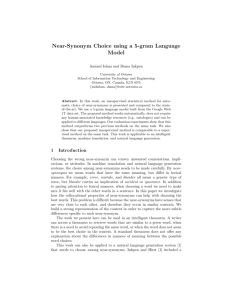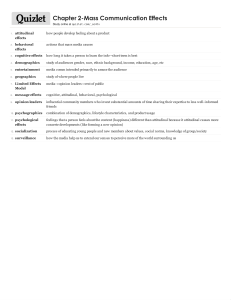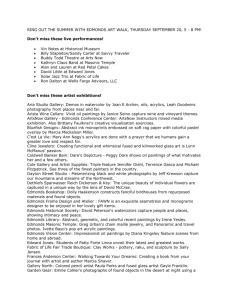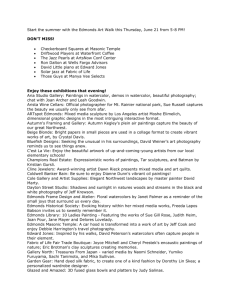Exploring approaches to discriminating among near
advertisement
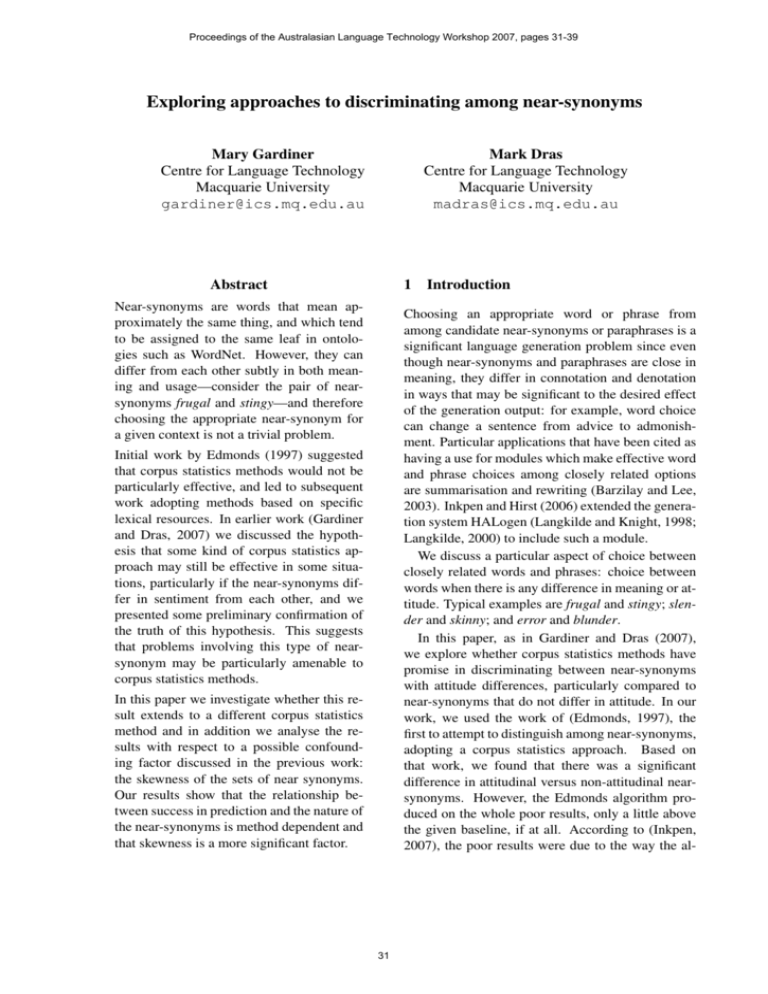
Proceedings of the Australasian Language Technology Workshop 2007, pages 31-39
Exploring approaches to discriminating among near-synonyms
Mary Gardiner
Centre for Language Technology
Macquarie University
gardiner@ics.mq.edu.au
Mark Dras
Centre for Language Technology
Macquarie University
madras@ics.mq.edu.au
1
Abstract
Near-synonyms are words that mean approximately the same thing, and which tend
to be assigned to the same leaf in ontologies such as WordNet. However, they can
differ from each other subtly in both meaning and usage—consider the pair of nearsynonyms frugal and stingy—and therefore
choosing the appropriate near-synonym for
a given context is not a trivial problem.
Introduction
Choosing an appropriate word or phrase from
among candidate near-synonyms or paraphrases is a
significant language generation problem since even
though near-synonyms and paraphrases are close in
meaning, they differ in connotation and denotation
in ways that may be significant to the desired effect
of the generation output: for example, word choice
can change a sentence from advice to admonishment. Particular applications that have been cited as
having a use for modules which make effective word
and phrase choices among closely related options
are summarisation and rewriting (Barzilay and Lee,
2003). Inkpen and Hirst (2006) extended the generation system HALogen (Langkilde and Knight, 1998;
Langkilde, 2000) to include such a module.
We discuss a particular aspect of choice between
closely related words and phrases: choice between
words when there is any difference in meaning or attitude. Typical examples are frugal and stingy; slender and skinny; and error and blunder.
In this paper, as in Gardiner and Dras (2007),
we explore whether corpus statistics methods have
promise in discriminating between near-synonyms
with attitude differences, particularly compared to
near-synonyms that do not differ in attitude. In our
work, we used the work of (Edmonds, 1997), the
first to attempt to distinguish among near-synonyms,
adopting a corpus statistics approach. Based on
that work, we found that there was a significant
difference in attitudinal versus non-attitudinal nearsynonyms. However, the Edmonds algorithm produced on the whole poor results, only a little above
the given baseline, if at all. According to (Inkpen,
2007), the poor results were due to the way the al-
Initial work by Edmonds (1997) suggested
that corpus statistics methods would not be
particularly effective, and led to subsequent
work adopting methods based on specific
lexical resources. In earlier work (Gardiner
and Dras, 2007) we discussed the hypothesis that some kind of corpus statistics approach may still be effective in some situations, particularly if the near-synonyms differ in sentiment from each other, and we
presented some preliminary confirmation of
the truth of this hypothesis. This suggests
that problems involving this type of nearsynonym may be particularly amenable to
corpus statistics methods.
In this paper we investigate whether this result extends to a different corpus statistics
method and in addition we analyse the results with respect to a possible confounding factor discussed in the previous work:
the skewness of the sets of near synonyms.
Our results show that the relationship between success in prediction and the nature of
the near-synonyms is method dependent and
that skewness is a more significant factor.
31
gorithm handled data sparseness; she consequently
presented an alternative algorithm with much better results. We also found that attitudinal versus
non-attitudinal near-synonyms differed significantly
in their baselines as a consequence of skewness of
synset distribution, complicating analysis.
In this paper then we develop an algorithm based
on that of Inkpen, and use a far larger data set
and a methodology suited to large data sets, to see
whether this alternative method will support our previous findings. In addition we analyse results with
regard to a measure of synset skewness. In Section 2 we outline the near-synonym task description; in Section 3 we present our method based on
Inkpen; in Section 5 we present out method based
on Inkpen, and our experimental method using it; in
Section 4 we evaluate its effectiveness in comparison with Inkpen’s own method; in Section 5 we test
our hypothesis, present our results and discuss them;
and in Section 6 we conclude.
2
Task Description
Our experiment tests a system’s ability to fill a gap in
a sentence from a given set of near-synonyms. This
problem was first described by Edmonds (1997).
Edmonds describes an experiment that he designed
to test whether or not co-occurrence statistics are
sufficient to predict which word in a set of nearsynonyms fills a lexical gap. He gives this example
of asking the system to choose which of error, mistake or oversight fits into the gap in this sentence:
(1)
However, such a move also of cutting
deeply into U.S. economic growth, which is
why some economists think it would be a
big
.
Performance on the task is measured by comparing system performance against real word choices:
that is, sentences such as example 1 are drawn from
real text, a word is removed, and the system is asked
to choose between that word and all of its nearsynonyms as candidates to fill the gap.
3
text: that described by Edmonds (1997) and that described by Inkpen (2007).
In our previous work we used Edmonds’ method
for discriminating between near-synonyms as a basis for comparing whether near-synonyms that differ
in attitude in predictability from near-synonyms that
do not. The more recent work by Inkpen is a more
robust and reliable approach to the same problem,
and therefore in this paper we develop a methodology based closely on that of Inkpen, using a different style of training corpus, in order to test whether
the differences between the performance of nearsynonyms that differ in sentiment and those that do
not persists on the better performing method.
Edmonds’ and Inkpen’s approaches to nearsynonym prediction have the same underlying hypothesis: that the choice between near-synonyms
can be predicted to an extent from the words immediately surrounding the gap. Returning to example 1, their approaches use words around the gap, eg
big, to predict which of error, mistake or oversight
would be used. They do this using some measure of
how often big, and other words surrounding the gap,
is used in contexts where each of error, mistake and
oversight are used. Edmonds uses every word in the
sentence containing the gap, whereas Inkpen uses a
generally smaller window of words surrounding the
gap.
In this section we briefly describe Edmonds’ approach to discriminating between near-synonyms in
Section 3.1 and describe Inkpen’s approach in more
detail in Section 3.2. We then describe our adaptation of Inkpen’s approach in Section 3.3.
3.1
Edmonds’ approach
In Edmonds’ approach to the word choice problem,
the suitability of any candidate word c for a sentence
S can be approximated as a score(c, S) of suitability, and where score(c,S) is a sum of the association
between the candidate c and every other word w in
the sentence.
(2)
score(c, S) =
X
sig(c, w)
w∈S
An approximation to Inkpen’s solution
to the near-synonym choice problem
We know of two descriptions of algorithms used
to choose between near-synonyms based upon con-
32
In Edmonds’ original method, which we used in
Gardiner and Dras (2007), sig(c, w) is computed using either the t-score of c and w or a second degree
association: a combination of the t-scores of c with
a word w0 and the same word w0 with w. Edmonds’
t-scores were computed using co-occurrence counts
in the 1989 Wall Street Journal, and the performance
did not improve greatly over a baseline of choosing
the most frequent word in the synset to fill all gaps.
that, for example, if q = 3, example 7 would count
as a co-occurrence of fresh and mango, but example 8 would not:
(7)
He likes fresh cold mango.
3.2
(8)
I like fresh fruits in general, particularly
mango.
Inkpen’s approach
In Inkpen’s method, the suitability of candidate c for
a given gap is approximated slightly differently: the
entire sentence is not used to measure the suitability
of the word. Instead, a certain sized window of k
words either side of the gap is used. For example, if
k = 3, the word missing from the sentence in example 3 is predicted using only the six words shown in
example 4.
(3)
Visitors to Istanbul often sense a second,
layer beneath the city’s tangible
beauty.
She also experimented with document counts
where C(x) is the number of documents that x is
found in and C(x, y) is the number of documents in
which both x and y are found, called PMI-IR (Turney, 2001); but found that this method did not perform as well, although the difference was not statistically significant.
Inkpen’s method outperformed both the baseline
and Edmonds’ method by 22 and 10 percentage
points respectively.
(4)
sense a second,
3.3
layer beneath the
Given a text fragment f consisting of
2k words, k words either side of a gap g
(w1 , w2 , . . . , wk , g, wk+1 , . . . , w2k ),
the
suitability s(c, g) of any given candidate word c to fill
the gap g is given by:
(5) s(c, g) =
k
X
j=1
PMI(c, wj ) +
2k
X
PMI(wj , c)
j=k+1
PMI(x, y) is the pointwise mutual information
score of two words x and y, and is given by (Church
and Hanks, 1991):
(6)
Our variation on Inkpen’s approach is designed to
estimate PMI(x, y), the pointwise mutual information of words x and y, using the Web 1T 5-gram
corpus Version 1 (Brants and Franz, 2006).
Web 1T contains n-gram frequency counts, up to
and including 5-grams, as they occur in a trillion
words of World Wide Web text. There is no context information beyond the n-gram boundaries. Examples of a 3-gram and a 5-gram and their respective counts from Web 1T are shown in examples 9
and 10:
(9)
means official and
(10)
Valley National Park 1948 Art
51
C(x, y) · N
PMI(x, y) = log2
C(x) · C(y)
C(x), C(y) and C(x, y) are estimated using token counts in a corpus: C(x, y) is the number of
times that x and y are found together, C(x) is the
total number of occurrences of x in the corpus and
C(y) the total number of occurrences of y in the corpus. N is the total number of words in the text.
Inkpen estimated C(x), C(y) and C(x, y) by
issuing queries to the Waterloo MultiText System (Clarke and Terra, 2003). She defined C(x, y)
the number of times where x is followed by y within
a certain query frame of length q within a corpus, so
33
Our variation of Inkpen’s approach
41
These n-gram counts allow us to estimate C(x, y)
for a given window width k by summing the Web
1T counts of k-grams in which words x and y occur
and x is followed by y.
Counts are computed using a an especially developed version of the Web 1T processing software
“Get 1T”1 originally described in Hawker (2007)
and detailed in Hawker et. al (2007). The Get 1T
software allows n-gram queries of the form in the
following examples, where <*> is a wildcard which
1
Available at http://get1t.sf.net/
will match any token in that place in the n-gram. In
order to find the number of n-grams with fresh and
mango we need to construct three queries:
(11)
<*> fresh mango
(12)
fresh <*> mango
(13)
fresh mango <*>
Since Web 1T contains 5-gram counts, we can use
query frame sizes from q = 1 (words x and y must
be adjacent, that is, occur in the 2-gram counts) to
q = 4.
3.4
Baseline method
However, in order to find fresh and mango within
4 grams we need multiple wildcards as in example 14, and added the embedded query hashing functionality described in Hawker et. al (2007).
The baseline method that our method is compared to
uses the most frequent word from a given synset as
the chosen candidate for any gap requiring a member of that synset. Frequency is measured using frequency counts of the combined part of speech and
word token in the 1989 Wall Street Journal.
(14)
4
fresh <*> <*> mango
Queries are matched case-insensitively, but no
stemming takes place, and there is no deeper analysis (such as part of speech matching).
This gives us the following methodology for a
given lexical gap g and a window of k words either
side of the gap:
1. for every candidate near-synonym c:
(a) for every word wi in the set of words
proceeding the gap, w1 , . . . , wk , calculate
PMI(wi , c) as in equation 6, given counts
for C(wi ), C(c) and C(wi , c) from Web
1T2
(b) for every word wj in the set of words following the gap, wk+1 , . . . , w2k , calculate
PMI(c, wj ) as in equation 6, given counts
for C(c), C(wj ) and C(c, wj ) from Web
1T
(c) compute the suitability score s(c, g) of
candidate c as given by equation 5
2. select the candidate near-synonym with the
highest suitability score for the gap where a single such candidate exists
3. where there is no single candidate with a highest suitability score, select the most frequent
candidate for the gap (that is, fall back to the
baseline described in Section 3.4)3
2
The result of equation 6 is undefined when any of C(x) =
0, C(y) = 0 or C(x, y) = 0 hold, that is, x or y or at least
one n-gram containing x and y cannot be found in the Web
1T counts. For the purpose of computing s(c, g), we define
PMI(x, y) = 0 when C(x) = 0, C(y) = 0 or C(x, y) = 0, so
that it has no influence on the score s(c, g) given by equation 5.
3
Typically, in this case, all candidates have scored 0.
34
Effectiveness of the approximation to
Inkpen’s method
In this section we compare our approximation of
Inkpen’s method described in Section 3.3 with her
method described in Section 3.2. This will allow us
to determine whether our approximation is effective
enough to allow us to compare attitudinal and nonattitudinal near-synonyms.
4.1
Test sets
In order to compare the two methods, we use five
sets of near-synonyms, also used as test sets by both
Edmonds and Inkpen:
• the adjectives difficult, hard and tough;
• the nouns error, mistake and oversight;
• the nouns job, task and duty;
• the nouns responsibility, burden, obligation
and commitment; and
• the nouns material, stuff and substance.
Inkpen compared her method to Edmonds’ using
these five sets and two more, both sets of verbs,
which we have not tested on, as our attitudinal
and non-attitudinal data does not included annotated
verbs. We are therefore interested in the predictive
power of our method compared to Inkpen’s and Edmond’s on adjectives and nouns.
4.2
Test contexts
We performed this experiment, as Edmonds and
Inkpen did, using the 1987 Wall Street Journal as
a source of test sentences.4 Where ever one of the
words in a test set is found, it is removed from the
context in which it occurs to generate a gap for the
algorithm to fill.
So, for example, when sentence 15 is found in the
test data, the word error is removed from it and the
system is asked to predict which of error, mistake or
oversight fills the gap at 16:
(15)
. . .his adversarys’ characterization of that
minor sideshow as somehow a colossal error on the order of a World War. . ..
(16)
a colossal
4.3
on the
Parameter settings
Recall from Section 3.2 these two parameters used
by Inkpen: k and q.
Parameter k is the size of the ‘window’ of context
on either side of a lexical gap in the test set: the
k words on either side of a gap are used to predict
which of the candidate words best fills the gap.
Parameter q is the query size used when querying
the corpus to find out how often words x and y occur
together in order to compute the value of C(x, y). In
order to be counted as occurring together, x and y
must occur within a window of length at most q.
Inkpen found, using Edmonds’ near-synonym set
difficult and hard as a development set, that results
are best for a small window (k ∈ {1, 2}) but that the
query frame had to be somewhat longer to get the
best results. Her results were reported using k = 2
and q = 5, chosen via tuning on the development
set.
We have retained the setting k = 2 and explored
results where q = 2 and q = 4: due to Web 1T
containing 5-grams but no higher order n-grams we
cannot measure the frequency of two words occurring together with any more than three intervening
words, so q = 4 is the highest value q can have.
4.4
Results and Discussion
Table 1 shows the performance of Edmonds’ method
and Inkpen’s method as given in Inkpen (2007)5 and
4
All references to the Wall Street Journal data used in this
paper refer to Charniak et. al (2000).
5
Inkpen actually gives two methods, one using PMI estimates from document counts, one using PMI estimates using
word counts. Here we are discussing her word count method
and use those values in our table.
35
our modified method on each of the test sets described in Section 4.1. Note that Inkpen reports different baseline results from us—we have not been
able to reproduce her baselines. This may be due
to choosing different part of speech tags: we simply
used JJ for adjectives and NN for nouns.
Inkpen’s improvements for the test synsets given
in Section 4.1 were between +3.2% and 30.6%. Our
performance is roughly comparable, with improvements as high as 31.2%. Further, we tend to improve
especially largely over the baseline where Inkpen
also does so: on the two sets error etc and responsibility etc..
The major anomaly when compared to Inkpen’s
performance is the set job, task and duty, where
our method performs very badly compared to both
Edmonds’ and Inkpen’s methods and the baseline
(which perform similarly). We also perform under
both methods on material, stuff and substance, although not as dramatically.
Overall, the fact that we tend to improve over Edmonds where Inkpen also does so suggests that our
algorithm based on Inkpen’s takes advantage of the
same aspects as hers to gain improvements over Edmonds, and thus that the method is a good candidate
for use in our main experiment.
5
Comparing attitudinal and
non-attitudinal synsets
Having determined in Section 4 that our modified
version of Inkpen’s method performs as a passable
approximation of hers, and particularly that where
her method improved dramatically over the baseline
and Edmonds’ method that ours improves likewise,
we then tested our central hypothesis: that attitudinal synsets respond better to statistical prediction
techniques than non-attitudinal synsets.
5.1
Test set
In order to test our hypothesis, we use synsets divided into near-synonym sets that differ in attitudinal and sets that do not.
This test set is drawn from our set of annotated
attitudinal and non-attitudinal near-synonyms described in Gardiner and Dras (2007). These are
WordNet2.0 (Fellbaum, 1998) synsets whose members occur particularly frequently in the 1989 Wall
Set
Inkpen’s
baseline
value %
difficult etc.
error etc.
job etc.
responsibility etc.
material etc.
41·7
30·9
70·2
38·0
59·5
Edmonds’
increase
over
baseline
%
Inkpen’s
increase
over
baseline
(q = 5) %
No. test
sentences
we found
Our baseline value
%
+6·2
+18·9
−1·3
+7·3
+5·1
+17·4
+30·6
+3·2
+28·0
+12·7
5959
1026
4020
1119
934
44·3
46·8
74·2
36·7
57·8
Our
increase
over
baseline
%
q=2 q=4
+15·3 +12·3
+25·5 +20·4
−14·4 −23·0
+31·2 +24·9
+5·5
−1·1
Table 1: Performance of Inkpen’s test sentences on Edmond’s method, Inkpen’s method and our method
(k = 2)
Street Journal. The synsets were annotated as attitudinal and non-attitudinal by the authors of this
paper. Synsets were chosen where both annotators
are certain of their label, and where both annotators
have the same label. This results in 60 synsets in total: 8 where the annotators agreed that there was definitely an attitude difference between words in the
synset, and 52 where the annotators agreed that there
were definitely not attitude differences between the
words in the synset.
An example of a synset agreed to have attitudinal
differences was:
(17)
5.2
sphere, domain, area, orbit, field, arena
The synsets are not used in their entirety, due to
the differences in the number of words in each synset
(compare {violence, force} with two members to
{arduous, backbreaking, grueling, gruelling, hard,
heavy, laborious, punishing, toilsome} with nine,
for example). Instead, a certain number n of words
are selected from each synset (where n ∈ {3, 4})
based on the frequency count in the 1989 Wall Street
Journal corpus. For example hard, heavy, gruelling
and punishing are the four most frequent words
in the {arduous, backbreaking, grueling, gruelling,
hard, heavy, laborious, punishing, toilsome} synset,
so when n = 4 those four words would be selected.
When the synset’s length is less than or equal to n,
36
Test contexts
Exactly as in Section 4.2, our lexical gaps and their
surrounding contexts are drawn from sentences in
the 1987 Wall Street Journal containing one of the
words in the test synsets.
5.3
bad, insecure, risky, high-risk, speculative
An example of synsets agreed to not have attitudinal differences was:
(18)
for example when n = 4 but the synset is {violence,
force}, the entire synset is used.
These test sets are referred to as top3 (synsets reduced to 3 or less members) and top4 (synsets reduced to 4 or less members).
Parameter settings
As described in Sections 3.2 and 4.3, there are two
parameters that can be varied regarding the context
around a lexical gap (k), and the nearness of two
words x and y in the corpus in order for them to be
considered to occur together (q).
As per Inkpen’s results on her development set,
and as in Section 4 we use the setting k = 2 and
vary q such that q = 2 on some test runs and q = 4
on others. We cannot test with Inkpen’s suggested
q = 5, as that would require 6-grams.
5.4
Results and Discussion
The overall performance of our method on our sets
of attitudinal and non-attitudinal near-synonyms is
shown in Table 2.
We did four test runs in total, two each on sets
top3 and top4 varying q between q = 2 and q = 4.
The baseline result does not depend on q and therefore is the same for both tests of top3 and of top4.
Synsets
top3
Contexts containing a test
word
Att.
Non-att.
45953
353155
top4
48515
Baseline correctness (%)
Att.
357290
59·52
Non-att.
69·71
56·37
68·91
q
2
4
2
4
Our method’s correctness
(%)
Att.
Non-att.
59·51
69·95
56·93
69·96
52·26
67·60
50·82
67·59
Table 2: Performance of the baseline and our method on all test sentences (k = 2)
Improvement
baseline
over
≥ +20%
≥ +10% and < +20%
≥ +5% and < +1%
> -5% and < -5%
≤ -5% and > -10%
≤ -10% and > -20%
≤ -20%
Number of synsets
Att.
0
1
2
2
0
1
1
Non-att.
16
7
2
10
6
3
8
Total
16
8
4
12
6
4
9
Table 3: Distribution of improvements on baseline
for top3, k = 2, q = 2
As in our previous paper (Gardiner and Dras,
2007), the baselines behave noticeably differently
for attitudinal and non-attitudinal synsets. Calculating the z-statistic as is standard for comparing two
proportions (Moore and McCabe, 2003) we find that
the difference between the pair of attitudinal and
non-attitudinal results for each test are all statistically significant (p < 0.01). Thus, again, it is difficult from the data in Table 2 alone to determine
whether the better performance of non-attitudinal
synsets is due to the higher baseline performance for
those same synsets.
There are two major aspects of this result requiring further investigation. The first is that our method
performs very similarly to the baseline according to
these aggregate numbers, which wasn’t anticipated
based on the results in Section 4, which showed that
on a limited set of synsets our method performed
well above the baseline, although not as well as
Inkpen’s original method.
Secondly, inspection of individual synsets and
their performance reveals that this aggregate is not
representative of the performance as a whole: it is
37
simply an average of approximately equal numbers
of good and bad predictions by our method. Table 3
shows that for one test run (top3, k = 2, q = 2) there
were a number of synsets on which our method performed very well with an improvement of more than
20 percentage points over the baseline but also a substantial number where it performed very badly, losing more than 20 percentage points from the baseline.
In our previous work we expressed a suspicion
that the success of Edmonds’ prediction method
might be being influenced by the evenness of distribution of frequencies within a synset. That is, if
a synset contains a very dominant member (which
will cause the baseline to perform well) then the Edmonds method may perform worse against the baseline than it would for a synset in which the word
choices were distributed fairly evenly among the
members of the set.
Given the results of the test runs shown in Table 2,
and the wide distribution of prediction successes
shown in Table 3, we decided to test this hypothesis that the distribution of words in the synsets influence the performance of prediction methods that use
context. This is described in Section 5.4.1.
5.4.1
Entropy analysis
In this section, we describe an analysis of the results in Section 5.4 in terms of whether the balance
of frequencies among words in the synset contribute
to the quality of our prediction result.
In order to measure a correlation between the balance of frequencies of words and the prediction result, we need a measure of ‘balance’. In this case we
have chosen information entropy (Shannon, 1948),
the measure of bits of information required to convey a particular result. The entropy of a synset’s
frequencies here is measured using the proportion
Test set
top3
top3
top4
top4
q
2
4
2
4
Category
−0·11
−0·10
−0·17∗
−0·15∗
Entropy
0·41∗
0·36∗
0·38∗
0·34∗
Table 4: Regression co-efficients between independent variables synset category and synset entropy, and dependent variable prediction improvement over baseline (statistically significant results
p < 0.05 marked *)
of total uses of the synset that each particular word
represents. A synset in which frequencies are reasonably evenly distributed has high information entropy and a synset in which one or more words are
very frequent as a proportion of use of that synset as
a whole have low entropy.
We then carried out multiple regression analysis
using the category of the synset (attitudinal or not
attitudinal, coded as 1 and 0 for this analysis) and
the entropy of the synset’s members’ frequencies as
our two independent variables; this allows us to separate out the two effects of synset skewness and attitudinality. Regression co-efficients are shown in
Table 4.
Table 4 shows that in general, performance is negatively correlated with both category but positively
with entropy, although the correlation with category
is not always significant. The positive relationship
with entropy confirms our suspicion in Gardiner and
Dras (2007) that statistical techniques perform better when the synset does not have a highly dominant
member. The negative correlation with category implies that the reverse of our main hypothesis holds:
that our statistical method works better for predicting the use of non-attitudinal near-synonyms.
There are two questions that arise from the result
that our Inkpen-based method gives a different result
from the Edmonds-based one.
First, is our approximation to Inkpen’s method inherently faulty or can it be improved in some way?
We know from Section 4 that it tends to perform
well where her method performs well. An obvious
second test is to compare our results to another test
described in Inkpen (2007) which used a larger set
of near-synonyms and tested the predictive power
38
using the British National Corpus as a source of
test contexts. This test will test our system’s performance in genres quite different from news-wire
text, and allow us to make a further comparison with
Inkpen’s method.
Second, why do we perform significantly better
for near-synonyms without attitude difference? One
possible explanation that we intend to explore is that
attitude differences are predicted by attitude differences exhibited in a very large context; perhaps an
entire document or section thereof. Sentiment analysis techniques may be able to be used to detect the
attitude bearing parts of a document and these may
serve as more useful features for predicting attitudinal word choice than surrounding words.
6
Conclusion and Future Work
In this paper we have developed a modification to
Inkpen’s method of making a near-synonym choice
that on a set of her test data performs reasonably
promisingly; however, when tested on a larger set
of near-synonyms on average it does not perform
very differently to the baseline. We have also shown
that, contrary to our hypothesis that near-synonyms
with attitude differences would perform better using statistical methods, on this method the nearsynonyms without attitude differences are predicted
better when there’s a difference in predictive power.
Ultimately, we plan to develop a system that
will acquire and predict usage of attitudinal nearsynonyms, drawing on statistical methods and methods from sentiment analysis. In order to achieve this
we will need a comprehensive understanding of why
this method’s performance was not adequate for the
task.
Acknowledgements
Thank you to: Diana Inkpen for sending us a copy of
Inkpen (2007) while it was under review; and Tobias
Hawker for providing a copy of his Web 1T processing software, Get 1T, before its public release.
This work has been supported by the Australian Research Council under Discovery Project
DP0558852.
References
Regina Barzilay and Lillian Lee. 2003. Learning to
paraphrase: An unsupervised approach using multiplesequence alignment. In HLT-NAACL 2003: Main Proceedings, pages 16–23.
Thorsten Brants and Alex Franz. 2006. Web 1T 5-gram
Version 1.
http://www.ldc.upenn.edu/
Catalog/CatalogEntry.jsp?catalogId=
LDC2006T13.
Eugene Charniak, Don Blaheta, Niyu Ge, Keith Hall,
John Hale, , and Mark Johnson. 2000. BLLIP
1987-89 WSJ Corpus Release 1. http://www.
ldc.upenn.edu/Catalog/CatalogEntry.
jsp?catalogId=LDC2000T43.
Kenneth Church and Patrick Hanks. 1991. Word association norms and mutual information, lexicography.
Computational Linguistics, 16(1):22–29.
Charles L. A. Clarke and Egidio L. Terra. 2003. Passage
retrieval vs. document retrieval for factoid question answering. In Proceedings of the 26th Annual International ACM SIGIR Conference on Research and Development in Information Retrieval, pages 427–428,
Toronto, Canada.
Philip Edmonds. 1997. Choosing the word most typical
in context using a lexical co-occurrence network. In
Proceedings of the 35th Annual Meeting of the Association for Computational Linguistics and the 8th Conference of the European Chapter of the Association for
Computational Linguistics, pages 507–509, July.
Christiane Fellbaum, editor. 1998. WordNet: An Electronic Lexical Database. The MIT Press, May.
Mary Gardiner and Mark Dras. 2007. Corpus statistics
approaches to discriminating among near-synonyms.
In Proceedings of the 10th Conference of the Pacific
Association for Computational Linguistics (PACLING
2007), pages 31–39, Melbourne, Australia, September.
Tobias Hawker, Mary Gardiner, and Andrew Bennetts.
2007. Practical queries of a massive n-gram database.
In Proceedings of the Australasian Language Technology Workshop 2007 (ALTW 2007), Melbourne, Australia. To appear.
Tobias Hawker. 2007. USYD: WSD and lexical substitution using the Web 1T corpus. In Proceedings of
SemEval-2007: the 4th International Workshop on Semantic Evaluations, Prague, Czech Republic.
Diana Inkpen and Graeme Hirst. 2006. Building and
using a lexical knowledge-base of near-synonym differences. Computational Linguistics, 32(2):223–262,
June.
39
Diana Inkpen. 2007. A statistical model of nearsynonym choice. ACM Transactions of Speech and
Language Processing, 4(1):1–17, January.
Irene Langkilde and Kevin Knight. 1998. The practical
value of N-grams in generation. In Proceedings of the
9th International Natural Language Generation Workshop, pages 248–255, Niagra-on-the-Lake, Canada.
Irene Langkilde. 2000. Forest-based statistical sentence
generation. In Proceedings of the 1st Conference of
the North American Chapter of the Association for
Computational Linguistics and the 6th Conference on
Applied Natural Language Processing (NAACL-ANLP
2000), pages 170–177, Seattle, USA.
David S. Moore and George P. McCabe. 2003. Introduction to the Practice of Statistics. W. H. Freeman and
Company, 4 edition.
Claude E. Shannon. 1948. A mathematical theory
of communication. Bell System Technical Journal,
27:379–423 and 623–656, July and October.
Peter Turney. 2001. Mining the web for synonyms:
PMI-IR versus LSA on TOEFL. In Proceedings of
the Twelfth European Conference on Machine Learning (ECML 2001), pages 491–502, Freiburg and Germany.
